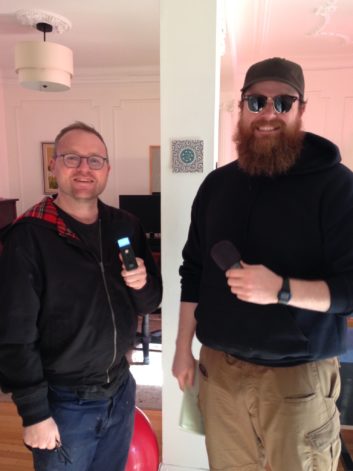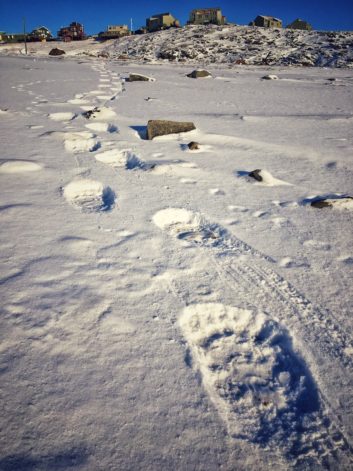OTTAWA, Ontario — It is a truism of the internet age that business people can successfully collaborate over the web, without ever meeting in person. CBC Radio producers Craig Desson and Kieran Oudshoorn recently put this theory to the test, by co-producing the hour-long network radio show, “Us, But Nobody Is Here” while separated by a distance of 2,000 kilometers (1,240 miles).

Available online, “Us, But Nobody is Here” explores the realities of long-distance business and personal relationships at a time where the web is said to bridge all gaps. The program does this through interviews with various people trying to make tech-aided long distance relationships work — including Craig Desson and Kieran Oudshoorn as they craft this show without meeting in person. Their separation was very real. Desson is based at CBC Montreal in Quebec, while Oudshoorn is about more than 2,000 kilometers north of him in Iqaluit, Nunavut; on Baffin Island in the Canadian Arctic.
PERSONAL EXPERIENCE
The impetus for “Us, But Nobody Is Here” came from Oudshoorn’s move to CBC Iqaluit after working in southern Canada throughout his radio career.
“I moved to a place that is incredibly physically isolated from my friends and family down south,” Oudshoorn said. “I decided that to find ways to keep in touch through technology, to maintain my relationships in my personal life.”
After Oudshoorn and Desson met through a mutual CBC associate — remotely, of course — the pair realized that what Oudshoorn was dealing with was actually becoming a universal experience due to telecommuting and social media. This insight inspired them to pitch and then win approval to produce “Us, But Nobody Is Here” as a national holiday broadcast for Jan 1.

“We’re increasingly living in a world where geography is supposed to be meaningless; where we’re told that you can do anything from anywhere,” said Desson. “With this program we decided to push this idea to the limits, from seeing what the realities of today’s remote relationships are like to the various aids that can help bridge this emotional distance.”
Desson and Oudshoorn started fleshing out their program in March 2019, working out of their respective homes, CBC Radio facilities and local communities. “The initial production process entailed a lot of phone calls and emails,” said Oudshoorn. “We sketched out the main ideas in Google Docs, which allowed us to share the developing storyline over the web and work on it together in real-time.”
EMOJIS MATTER
Working in this way limited the degree between the two producers. Having never met in person they had no real sense of who the other was. This is why Desson and Oudshoorn decided to also connect by videoconferences, “which allowed us to at least see some of each other’s body language,” Desson said. “Sometimes we would go into radio studios in our stations and connect to interviewees in other cities over ISDN phone lines in order to get broadcast quality audio remotely.”

One tool that proved unexpectedly useful were emojis in emails and texts. “There are so many animal layers to in-person interactions, which don’t come across when you are communicating remotely,” said Desson. “Used thoughtfully, emojis can be an effective graphical shorthand to tell the other person what you are feeling as you are writing something.”
Much of the field audio used in “Us, But Nobody Is Here” was captured using a range of Zoom handheld digital audio recorders with built-in microphones. “Kieran is the King of the Zoom recorders,” Desson said. “He’s got about every model that is currently available, and he used them all to record the show.”
A case in point: “Craig and I recorded my remote interactions for use in the program, which included me walking out in the Arctic tundra in the middle of nowhere, talking to him on my cellphone and capturing the audio on my Zoom,” said Oudshoorn.
PRODUCTION LIMITS
The growing multichannel program was mixed on their personal computers using Adobe Audition. Desson and Oudshoorn took turns adding content and making changes, and then shared the updated file with the other via the web.

“This is where we ran into problems,” Oudshoorn said. “There would be disconnects where one of us had done edits and pieces would be somehow go missing in the mix, forcing us to repopulate it all again. What was fascinating was the difficulty we had in communicating editing nuances to each other over the distance. Without hearing the same thing in the same room together at the same time, it was hard for us to understand what each of us was getting at creatively.”
It wasn’t until October 2019 that Craig Desson and Kieran Oudshoorn met in person. They came together at CBC Montreal to finish mastering the program using the corporation’s Dalet audio production system.
“Working in the same space, we were able to get quite a lot done in a short time period,” said Oudshoorn. “But then again, we had already built a relationship remotely that we were able to draw upon. So we were already very comfortable together and on a similar wavelength.”
Having put remote radio production to the test, what did they learn from the experience? And what would they do differently next time?
These answers weren’t evident in the initial interview this reporter conducted with Desson and Oudshoorn during a three-way teleconference between Ottawa, Iqaluit and Montreal. So, in the spirit of remote collaboration, I sent them a draft of this text, so that they could add their own conclusions directly.
“It was a great way to get things rolling,” said Desson. “However, you still feel that remote tech is a lower bandwidth than the real world. It takes longer to communicate ideas and sharing project files has a long way to go. That being said, working remotely opened a door for us to collaborate that wouldn’t be there if it weren’t for all these collaboration tools,” he said.
“Out of sight, out of mind: It’s painful how accurate this truism is,” said Oudshoorn. “It takes real intent to break through and connect at a distance. This is one of the lessons I learned, be intentional. My distance relationships are all the more rich now because I now go into them with focused attention.”
“This goes double for working at a distance like Craig and I did,” he added. “We were intentional about the time we took to be friendly and shoot the breeze when we talked, and we were intentional when we got down to business and made sure our work was done. As communication technology continues to change and improve we must be intentional about harnessing its possibilities and minding its pitfalls.”












